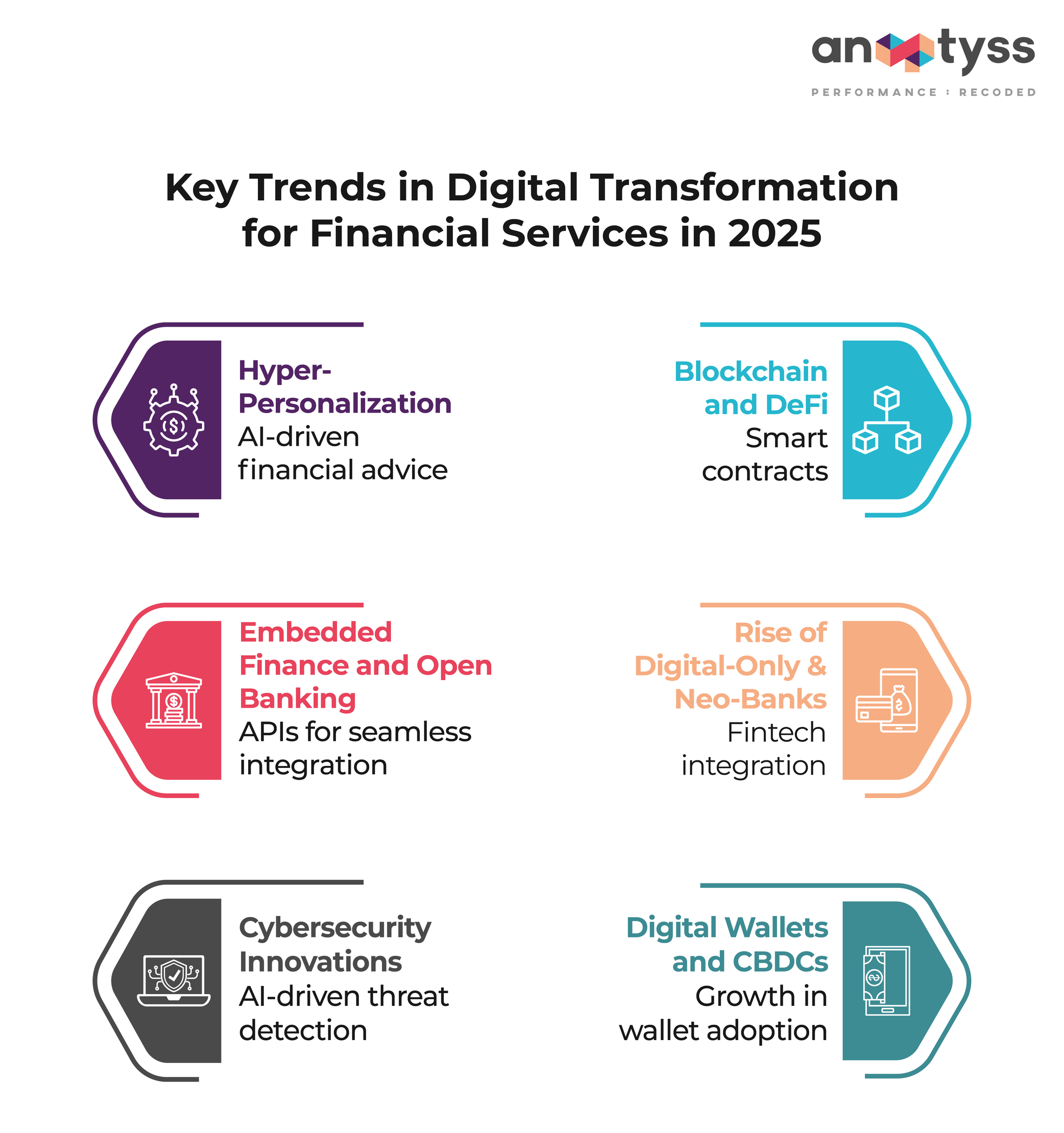Digital transformation in financial services isn’t just about online banking anymore. It’s about so much more—think mobile apps, e-payment systems, and cutting-edge technologies like artificial intelligence (AI), machine learning, and blockchain. These tools are revolutionizing how banks and financial institutions operate, boosting efficiency and taking customer experiences to the next level.
Looking ahead to 2025, we can expect digital transformation to keep disrupting the financial world with new, game-changing trends emerging and reshaping the industry in ways we can’t fully imagine yet.
In this article, we’ll dive into the big trends driving digital transformation in 2025.
Plus, we’ll break down how these innovations could change financial strategies, streamline operations, and improve customer experiences across the board.
Explore our white paper Digital‑Led Transformation – Financial Services for deeper insights.

1. Hyper-Personalization through AI and Machine Learning
Hyper-personalization is about to get a major upgrade thanks to advancements in AI and machine learning. These technologies will let financial institutions dive deep into data—everything from transaction histories to real-time online behavior. The result? Tailor-made products, services, and interactions for every single customer. As per reports, effective hyper-personalization can result in an 8x return on marketing investment and boost sales by 10% or higher.
Tailor-made experiences aren’t limited to banking. In insurance too, personalization has become key to customer satisfaction. Learn how hyper-personalization is reshaping insurance through customer-centric innovation.
- Real-Time Data Integration
By 2025, financial institutions will likely use real-time data streams to get insights into customer behavior, refine customer profiles, and deliver the right products at the right time from the right channel – the 3 R’s of hyper-personalization.
- AI-Driven Insights for Financial Wellness
AI could also create models to offer personalized tips for saving, spending, and investing, giving customers tools for better financial wellness.
- Enhanced Customer Segmentation
Financial institutions will segment customers into micro-categories using machine learning algorithms and offer precise and relevant products or services. Impact on Financial Services Hyper-personalization will drive customer satisfaction and loyalty. 84% of people say that being treated as a unique person is critical to winning their loyalty. By offering more tailored products and services, financial institutions will be able to increase customer engagement, enhance brand loyalty, and optimize customer lifetime value. For example, insurers might use this technology to identify low-risk customers for cheaper premiums. But beyond that, hyper-personalization could help them manage risks dynamically, making their processes even more efficient.
2. Rise of Digital-Only and Neo-Banks
The global neo-bank market is expected to accelerate at a compounded annual growth rate (CAGR) of around 46.5% between 2019 and 2026. It will generate around USD 394.6 billion by 2026 from USD 18.6 billion in 2018 – PwC. In 2025, these digital-only banks (aka neo-banks) will become even more popular. Neo-banks are online-only financial institutions with zero physical branches.
They appeal to people who prefer a fully digital banking experience. But don’t confuse them with digital banks, which are often offshoots of traditional banks operating entirely online.
These banks can offer cost-effective products and services at a faster pace and greater flexibility with near real-time accounting and reconciliation services. These banks are going to be more popular among the Gen-Z and younger, tech-savvy demographics. Some Neo Banks are becoming more sophisticated offering specialized services like cryptocurrency support.
To stay relevant, traditional banks are increasingly adopting digital-first delivery models and outsourcing models that align with agility and speed. See how managed services differ from traditional outsourcing in banking and why this matters more than ever.
- Expanded Service Offerings
Neo-banks will start offering more complex services like investment management and lending to compete directly with traditional banks.
- Integration with Fintech Ecosystems
By 2025, digital-only banks will partner with fintech companies to provide a comprehensive range of financial products in one digital ecosystem. Impact on Financial Services The rise of digital-only banks will challenge traditional banks to rethink their digital strategies. To compete, traditional institutions can adopt a hybrid model where they can work on enhancing their digital services while still offering the option of physical locations. Additionally, these conventional banks and financial services providers can create their digital-only brands to attract younger audiences.
3. Embedded Finance and Open Banking
Imagine paying for something on a shopping app or social media platform without switching to a banking app. That’s embedded finance in action. By 2025, this trend will be everywhere, integrating financial services into non-financial platforms like e-commerce or ride-hailing apps.
Open banking, on the other hand, is a market-driven and regulated framework that enables consumers to share their financial data securely with third parties through APIs, making embedded finance possible.
This makes it easier for the customers to move between providers and enjoy seamless financial experiences. Underpinning these innovations are modern architectures. Implementing microservices in financial systems is a strategic move enabling the agility required for seamless integration via APIs.
- Finance in Everyday Platforms
In 2025, more non-financial platforms, like e-commerce sites or social media, will offer financial services, including payments, lending, and insurance.
- Cross-Industry Partnerships
Traditional banks will partner with various industries to integrate their services seamlessly into other digital experiences, offering consumers more ways to access financial products.
- B2B Embedded Finance
In addition to consumer applications, businesses will leverage embedded finance for services like automated invoicing, payroll, and lending directly within business management platforms. Impact on Financial Services Embedded finance and open banking are going to democratize access to financial services and provide a more seamless experience that will drive customer loyalty and engagement. It will also promote innovation and competition in the industry and strengthen customer data portability. Therefore, banks and financial institutions must adapt by:
- Creating APIs
- Collaborating with third-party providers
- Rethinking revenue models as transactions happen outside of traditional banking apps
4. Blockchain and Decentralized Finance (DeFi)
Blockchain technology and DeFi platforms are set to revolutionize the financial services industry in 2025 by offering more secure, transparent, and decentralized alternatives to traditional financial systems.
DeFi runs on blockchain technology to manage financial transactions and blockchain ensures transparency and efficiency. This makes it particularly appealing for financial transactions, enabling faster settlements, reduced fraud, and enhanced security.
It also aims to democratize finance by replacing legacy, centralized institutions with peer-to-peer relationships that can provide a full spectrum of financial services, from everyday banking, loans, and mortgages, to complicated contractual relationships and asset trading.
However, with the rise of DeFi, regulatory compliance is becoming more complex. Explore the challenges of cryptocurrency and money laundering and how banks can prepare for them.
- Smart Contracts for Automation
DeFi platforms use smart contracts to automate transactions, eliminating intermediaries and reducing costs. In 2025, smart contracts will find applications in everything from lending to insurance.
- Tokenization of Assets
The tokenization of assets, including real estate, art, and commodities, will gain traction, providing new investment opportunities.
- Cross-Border Payments
Blockchain-powered payment networks will streamline cross-border transactions, making them faster and more affordable for consumers and businesses alike. Impact on Financial Services Blockchain and DeFi pose a challenge to traditional financial institutions, potentially disrupting their role as intermediaries. To adapt, banks may explore partnerships with blockchain-based platforms or integrate DeFi solutions into their services to remain competitive.
5. Digital Wallets and Central Bank Digital Currencies (CBDCs)
In 2025, digital wallets and Central Bank Digital Currencies (CBDCs) are expected to play a larger role in the financial ecosystem with potential wide use by households and businesses to store value and make payments. Similar to physical currency in circulation, digital currency is traditional money but in digital form issued by the central bank in the country (such as the US dollar). It’s a legal tender with the central bank’s accountability. Rapid economic digitization, the demand for real-time payments and settlement, and the need for more effective domestic and international financial transactions are the main factors driving the need for CBDCs. Digital wallets have already become popular for their convenience in making contactless payments, and CBDCs offer a new digital form of government-backed currency. Australia’s trailblazing national green bank, the Clean Energy Finance Corporation, has already facilitated more than $37 billion in investments over 10 years.
- Growth of Digital Wallet Adoption
Digital wallets will become a mainstream payment method, with more financial institutions developing proprietary digital wallets to compete with tech giants.
- CBDC Pilots and Rollouts
Many countries will launch CBDCs to provide their citizens with secure, government-backed digital currency alternatives.
- Integration with E-commerce
As digital wallets become ubiquitous, they will integrate seamlessly with e-commerce platforms, simplifying checkout processes and reducing transaction times. Impact on Financial Services Digital wallets and CBDCs will require financial institutions to reimagine how they handle currency, payments, and customer interactions. Banks and payment providers may need to upgrade their infrastructure to support digital wallets and CBDC transactions, ensuring that they can compete in this evolving landscape.
Conclusion
Digital transformation in financial services is going to disrupt the banking and financial industry dramatically in 2025. It’s going to reshape customer experiences, business models, and operational efficiencies.
Some of the trends outlined above—including hyper-personalization, digital-only banking, embedded finance, blockchain, cybersecurity advancements, and digital wallets—will redefine how financial institutions engage with their customers and deliver value.
And as GenAI becomes more integral to strategic execution, institutions must be ready. Check out our white paper on Generative & Agentic AI in banking to see what’s next in AI-led transformation.
Ready to stay ahead in the fast-changing world of financial services? Partner with Anaptyss to navigate the digital transformation journey. To know more, reach us at info@anaptyss.com



